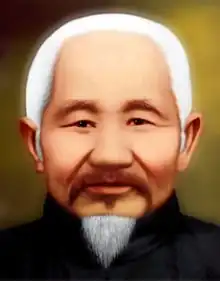Lu Zhongyi
Lu Zhongyi (Chinese: 路中一; 18 May 1849 – 26 February 1925) was the seventeenth patriarch of Yiguandao. His religious titles were Tung Li Zu and Jin Gong Zu Shi (金公祖師; Golden Elder). Lu is, according to Yiguandao doctrine, the incarnation of Maitreya.
Lu Zhongyi | |||||||||
|---|---|---|---|---|---|---|---|---|---|
路中一 | |||||||||
 Portrait from the Fa Yi Chong De Branch temple | |||||||||
| Title | 17th Taoist Patriarch (Yiguandao) | ||||||||
| Personal | |||||||||
| Born | 16 October 1895 | ||||||||
| Died | 26 February 1925 (aged 75) | ||||||||
| Religion | Taoism | ||||||||
| Sect | Yiguandao | ||||||||
| Other names |
| ||||||||
| Senior posting | |||||||||
| Period in office | 1905 – 1925 | ||||||||
| Predecessor | Liu Qingxu | ||||||||
| Successor | |||||||||
| Reincarnation | Maitreya | ||||||||
| Chinese name | |||||||||
| Traditional Chinese | 路中一 | ||||||||
| Simplified Chinese | 路中一 | ||||||||
| |||||||||
He was born on the 24th day of 4th Lunar month in 1849, in Jining, in China's Shandong province. He was said to be illiterate, his father died when he was young, left with his mother and sister Lu Zhongjie. He joined the army at age 22 and became an officer in the Manzhou Dongbei (Manchuria) government. In 1895, at the age of 46, he was said to have a dream from God instructing him to become the student of the 16th patriarch Liu Qingxu (Wang Jueyi's successor).
He became the 17th patriarch of Yiguandao in 1905, in Qingzhou. Yiguandao followers believe that he is the first leader of the "White Sun" Era, the last era of the Three Stages Final Kalpa, thus he is the incarnation of savior Maitreya or Hotei. In 1918, Lu brought Yiguandao to his hometown of Jining, within a few years, Lu managed to attract some 25 disciples, among them Zhang Tianran and Sun Suzhen.
Death
Lu died on the 2nd day of the 2nd lunar month in 1925. Thus, Lu's younger sister Lu Zhongjie (also known as Lao Gu Nai Nai, Mistress of the Old Cave) who was believed to be the incarnation of bodhisattva Guanyin, took over the leadership for six years.
Zhang and Sun became the successor through spirit writing by the Heavenly Mother. However, the other seven major disciples of Lu refused his succession. In 1930, Zhang officially was bestowed the leadership as the 18th patriarch of Yiguandao in Jinan.
References
- Thomas DuBois. 2005. The Sacred Village: Social Change and Religious Life in Rural North China. University of Hawai'i Press. ISBN 0-8248-2837-2
- David Jordan & Daniel Overmyer. 1985. The Flying Phoenix: Aspects of Chinese Sectarianism in Taiwan. Princeton University Press.
- Soo Khin Wah. 1997. A Study of the Yiguan Dao (Unity Sect) and its Development in Peninsular Malaysia. Ph.D. dissertation, University of British Columbia.